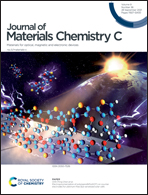A nanoscale continuous transition from the monoclinic to ferroelectric orthorhombic phase inside HfO2 nanocrystals stabilized by HfO2 capping and self-controlled Ge doping†
Abstract
Orthorhombic HfO2 exhibits nanoscale ferroelectricity that opens the perspective of ultra-scalable CMOS integration of ferroelectric memories. However, many aspects of the metastable orthorhombic crystallization mechanisms still need to be elucidated and new fabrication methods are of high interest. In this paper, the atomically resolved crystal structure of HfO2 is a 3-layer structure with a Ge-rich HfO2 intermediate layer capped by a top (cap) HfO2 layer and cladded by a bottom HfO2 layer. There is a continuity of crystal growth from the top and bottom HfO2 layers into the intermediate layer. A spatial transition from a monoclinic phase to an orthorhombic phase was revealed within a region of a few atomic layers at the interface between capped and intermediate HfO2 layers. This result suggests the mechanism of orthorhombic and monoclinic phase formation by a martensitic-like transformation of the initially grown tetragonal phase. The sample fabrication method we used involved magnetron sputtering deposition of the 3-layer structures, i.e. a stack of top HfO2/Ge-rich HfO2 intermediate/bottom HfO2 layers, followed by rapid thermal annealing. It results in self-optimized orthorhombic crystallization of HfO2 by Ge nanoparticle segregation in the intermediate layer. The ferroelectric effects are revealed by polarization–voltage hysteresis loops and piezoresponse force microscopy measurements. The atomistic computations performed by using the density functional theory support the experimental results by showing that the Ge doping of HfO2 leads to orthorhombic phase stabilization and increased Berry phase polarization.



 Please wait while we load your content...
Please wait while we load your content...